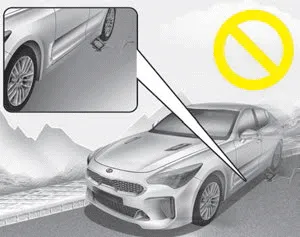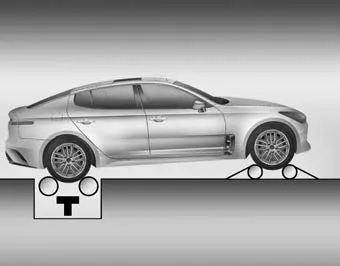Kia Stinger CK: All Wheel Drive (AWD) / Emergency precautions
Contents:
Tires
WARNING
Do not use tires and wheels of a different size and type than the ones originally installed on your vehicle. It can affect the safety and performance of your vehicle, which could lead to increased steering difficulty or rollover causing serious injury.
When replacing the tires, be sure to equip all four tires with the tire and wheel of the same size, type, tread, brand and load-carrying capacity.
In case of emergency such as tire puncture, repair it using TMK (Tire Mobility Kit) for temporary use. Afterwards, have the tire be inspected by an authorized Kia dealer.
WARNING

Never start or run the engine while an AWD vehicle is raised on a jack.The vehicle can slip or roll off of a jack causing serious injury or death to you or those nearby.
Towing
AWD vehicles must be towed with a wheel lift and dollies or flatbed equipment with all the wheels off the ground. For more information, refer to "Towing" in chapter 6.
Vehicle inspection
- When the vehicle is on a car lift, do not operate the front and rear wheels separately. All four wheels should be operated.
- Never engage the parking brake while running the engine on a car lift. This may damage the AWD system.
Dynamometer testing
An AWD vehicle must be tested on a special four wheel chassis dynamometer.

An AWD vehicle should not be tested on a 2WD roll tester. If a 2WD roll tester must be used, perform the following procedure:
1. Check the tire pressures recommended for your vehicle.
2. Place the rear wheels on the roll tester for a speedometer test as shown in the illustration.
3. Release the parking brake.
4. Place the front wheels on the temporary free roller as shown in the illustration.
WARNING
Keep away from the front of the vehicle while the vehicle is in gear on the dynamometer. The vehicle can jump forward and cause serious injury or death.
Other information:
Kia Stinger (CK) 2018-2023 Owner's Manual: Tire
Repair procedures Tire Wear • Using tires and wheels other than the recommended sizes can cause unusual handling characteristics and poor vehicle control, resulting in a serious accident. 1. Measure the tread depth of the tires.Kia Stinger (CK) 2018-2023 Owner's Manual: Electro Chromic Inside Rear View Mirror
Components and components location Components Description and operation Description The ECM (Electro Chromatic inside rear view Mirror) is one that automatically dims to protect the driver’s eyes when it senses light reflecting from the car behind. The sensor in the mirror detects the brightness and if the headlight from the car behind is reflected on the mirror, the chemical layer inside the mirror reacts to glare and adjusts the reflectivity from 10 to 70%.Categories
- Manuals Home
- Kia Stinger Owners Manual
- Kia Stinger Service Manual
- New on site
- Most important about car


